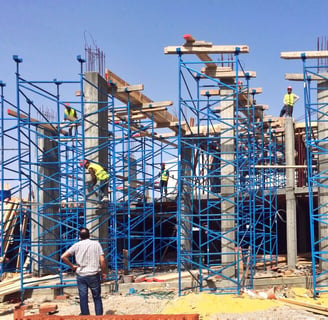Modern vs. Traditional Architecture: What’s Best for You?


Introduction to Architecture Styles
Architecture, as an art form, reflects society's values, technological advancements, and cultural influences over time. The evolution of architectural styles is a testament to humanity’s adaptability and creative ingenuity. Historically, traditional architecture can be traced back to ancient civilizations, where buildings were often constructed using locally sourced materials and techniques passed down through generations. These architectural forms, characterized by their ornamentation and craftsmanship, provided insights into the societal norms and aesthetic preferences of the eras in which they were built.
As societies advanced, particularly during the Industrial Revolution, architectural practices underwent significant transformations. The introduction of new materials, such as steel and glass, combined with progressive construction methods allowed architects to explore new creative avenues. Consequently, modern architecture emerged as a departure from traditional styles. This new movement sought to prioritize functionality, simplicity, and the embodiment of the contemporary spirit and technological progress. Modernism emphasized clean lines, open spaces, and minimalism, often discarding the elaborate ornamentation that defined traditional structures.
Today, the discourse surrounding architecture is not confined to a dichotomous view of modern versus traditional styles. It incorporates a multitude of influences that reflect globalization and an increased awareness of sustainable practices. Cultural traditions continue to inspire contemporary architecture, leading to hybrid designs that blend the old with the new. By examining the historical context and evolution of both traditional and modern architectural styles, readers can appreciate the nuances that inform architectural decisions and their impact on the built environment. This foundational understanding sets the stage for a deeper comparison between traditional and modern architecture, helping individuals determine which style resonates more with their personal preferences and needs.
Understanding Traditional Cameroonian Architecture
Traditional Cameroonian architecture embodies the rich cultural heritage and diversity of the nation, showcasing a variety of regional styles influenced by geography, climate, and ethnic traditions. One of the fundamental characteristics of this architecture is the utilization of local materials, such as mud, thatch, and wood, which reflect both the environmental context and the sustainable practices of indigenous builders. These materials not only provide structural integrity but also help in keeping interiors cool in the hot climate, illustrating a deep understanding of local conditions.
Central to traditional Cameroonian design is the emphasis on communal living. Many structures are organized around a courtyard, which serves as a communal space for families and extends hospitality. This design fosters social interaction, promoting a sense of community that is vital to Cameroonian culture. The layout often includes various functional spaces such as kitchens, living areas, and sleeping quarters, all connected harmoniously to enhance the daily lives of the inhabitants.
Moreover, traditional Cameroonian architecture is often adorned with cultural motifs and symbols that narrate stories and reflect societal values. For instance, the Bamileke people are known for their intricately carved wooden totems and masks that adorn their homes, representing ancestral lineage and cultural pride. The famous Beaux-Arts villages, significantly influenced by the Bantu ethos, provide insight into historical affluence through their elaborate residential complexes, demonstrating a wealth that transcends mere aesthetics.
Iconic structures such as the ‘ngon,’ a traditional round hut with a thatched roof, epitomize this architectural style, showcasing the ingenuity of Cameroonian builders. These structures not only serve practical purposes but also hold profound cultural significance. They encapsulate the essence of Cameroonian identity, merging function with tradition in a way that continues to influence contemporary architecture in the region.
Exploring Modern Architectural Designs
Modern architectural designs are characterized by their emphasis on minimalism, sustainability, and the integration of advanced technology, reflecting a shift in contemporary aesthetics and functionality. Minimalism in architecture promotes simplicity and the elimination of unnecessary elements, leading to structures that are not only visually appealing but also practical. The use of clean lines, open spaces, and a neutral color palette creates an atmosphere of tranquility and efficiency.
Sustainability is another hallmark of modern architecture, as designers increasingly prioritize environmentally friendly practices and materials. This trend is evident in the use of renewable resources, energy-efficient systems, and innovative designs that maximize natural light and ventilation. Structures such as the Bosco Verticale in Milan exemplify this approach, showcasing vertical forests that improve air quality and promote biodiversity while maintaining an urban lifestyle.
The integration of technology in modern architectural designs further enhances functionality and user experience. Smart home systems and automated features are becoming standard, allowing occupants to control lighting, heating, and security with ease. Moreover, technological advancements in building materials, such as self-healing concrete and high-performance insulation, ensure the longevity and durability of modern structures.
Globally, cities like Tokyo and Copenhagen are leading the way in modern architectural trends, with innovative skyscrapers and eco-friendly buildings redefining urban landscapes. Locally, architects are designing homes that resonate with their surrounding environments, employing modern techniques that harmonize with traditional elements. For instance, modern beach houses that incorporate local materials and styles while maximizing ocean views perfectly illustrate the blend of contemporary and regional design philosophies.
Overall, modern architectural designs not only fulfill aesthetic needs but also respond to pressing environmental challenges and technological advancements, offering solutions that enhance the living experience while keeping the planet's well-being in mind.
Comparative Analysis: Aesthetic Appeal vs. Functional Efficiency
When evaluating architectural styles, the contrast between traditional and modern designs often comes to the forefront, particularly in terms of aesthetic appeal and functional efficiency. Traditional architecture is characterized by intricate detailing, historical references, and a sense of nostalgia. Buildings designed in this style typically utilize materials such as brick, stone, and wood, which give them a timeless quality. This aesthetic charm can resonate deeply with clients who favor a classic look, stimulating a connection to the past and reinforcing cultural heritage.
In contrast, modern architecture emphasizes minimalism, simplicity, and functionality. This style often incorporates innovative materials such as glass and steel, creating clean lines and open spaces. The focus here lies in maximizing efficiency and utility, making it particularly appealing for projects where space and resource optimization are paramount. Modern designs can adapt to contemporary lifestyles and often promote sustainability through their design philosophy, integrating energy-efficient practices seamlessly into their structure.
Budget plays a critical role in determining which architectural style to pursue. Traditional designs may entail higher costs due to the labor-intensive craftsmanship required for ornate details and custom features. Conversely, while some modern buildings can be considerably less expensive owing to their straightforward construction methods, the use of high-tech materials may offset initial savings. Client preferences additionally steer the choice; clients aiming for a historic ambiance may gravitate towards traditional styles, whereas those favoring innovation and sustainability might be drawn to modern designs. Ultimately, the individual project's purpose, budgetary constraints, and client inclinations will profoundly influence the decision-making process between aesthetic appeal and functional efficiency in architecture.
Cultural Significance and Community Impact
Architecture serves as a mirror reflecting the values, beliefs, and cultural practices of a community. Traditional architecture holds a significant place in the historical narrative of societies, often embodying local customs, heritage, and identity. These structures, with their distinctive styles and materials, not only offer aesthetic appeal but also contribute to a sense of belonging. For many communities, preserving these traditional designs is crucial for maintaining cultural continuity and fostering intergenerational connections. Such preservation efforts help reinforce a community's narrative and instill pride among its members, as residents identify with the rich history encapsulated in these buildings.
On the other hand, modern architecture presents a contrasting but equally important aspect of community evolution. It emphasizes functionality, innovation, and adaptation, which can lead to significant socio-economic development. Communities embracing modern architectural practices often experience increased opportunities for collaboration and engagement, as these spaces can be designed to accommodate a variety of public uses. The flexibility of modern design allows for the creation of multifunctional spaces that meet the changing needs of their inhabitants. Furthermore, modern architecture can inspire creativity and forward-thinking, breaking away from the constraints of the past while still respecting it.
Balancing traditional and modern architectural styles poses a unique challenge for urban planners and community leaders. The integration of traditional elements within modern designs can create visually appealing spaces that honor cultural heritage while also fostering progress. This collaborative approach encourages social dynamics that benefit communities, as it enhances both historical appreciation and contemporary innovation. Ultimately, architecture—whether traditional or modern—exerts a powerful influence on community identity, shaping social interactions and fostering a shared sense of place.
Sustainability and Environmental Considerations
In the ongoing discourse surrounding architecture, sustainability has emerged as a critical factor informing design choices. Traditional architecture typically incorporates local materials and age-old techniques that often reflect a deep understanding of the environment. For instance, structures built using stone, timber, or clay not only harmonize with their surroundings but also have minimal environmental footprints. The passive solar design inherent in traditional homes, such as thick walls, strategic window placements, and natural ventilation, can significantly reduce energy consumption while promoting thermal comfort.
Conversely, modern architecture leverages technological advancements to embrace sustainability in innovative ways. The contemporary use of eco-friendly materials, such as recycled steel, bamboo, and sustainable concrete, demonstrates a shift towards minimizing resource depletion. Many modern structures are equipped with energy-efficient systems, including solar panels, geothermal heating, and smart technology that optimizes energy use based on real-time occupancy. These advancements allow architects to design buildings that not only meet the aesthetic demands of modernity but also prioritize eco-conscious living.
Both approaches to architecture have their own merits regarding sustainability. Traditional methods often rely on time-tested techniques, resulting in buildings that stand the test of time while requiring minimal energy expenditures. On the other hand, modern architecture actively seeks to mitigate environmental impacts through dynamic innovations, promoting a sustainable future. The integration of natural elements in design, along with energy-efficient systems, embodies a commitment to responsible building practices.
Ultimately, the choice between modern and traditional architecture may hinge on individual values regarding sustainability, aesthetics, and practicality. Selecting an architectural style that aligns with ecological considerations can foster a deeper connection between humans and their environment, underscoring the importance of mindful design in a rapidly changing world.
Making Your Choice: Factors to Consider
Choosing between modern and traditional architecture involves a careful assessment of various factors that can influence the suitability of either style for your project. One of the primary considerations is your personal style preferences. Modern architecture often emphasizes minimalism, clean lines, and open spaces, which can appeal to those seeking a contemporary aesthetic. In contrast, traditional architecture typically offers intricate detailing, rich materials, and a sense of historical continuity. Reflecting on your individual taste is crucial, as it sets the tone for your project.
Budget constraints also play a significant role in your decision-making process. Modern designs might often utilize new materials and construction methodologies that, while innovative, can lead to higher costs. Conversely, traditional architectural styles may require specific craftsmanship and materials that could be costly depending on the project's scope. Thus, any financial constraints should be taken into account early in the planning process to avoid overspending.
The environment of the building site serves as another critical factor. The local climate, topography, and cultural context can greatly influence the performance and acceptability of design choices. For instance, in regions prone to harsh weather conditions, a modern design might necessitate advanced materials and technologies to ensure durability, while traditional architecture may offer proven strategies suited for local conditions.
Lastly, the intended use of the space should guide your decision as well. Different architectural styles convey various functions and atmospheres, which can affect the usability and comfort of the space. If the area is intended for public use, modern architecture might attract more interest and responsiveness due to its innovative approach. In summary, weighing personal style, budget, environmental considerations, and functional needs is essential when making the choice between modern and traditional architecture for your next project.


